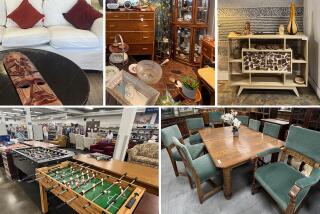Vintage that’s worth the toil
IN the eyes of furniture restorer Denise Karger, no vintage flea market find is too far gone for a 21st century revival. Her advice for that Alvar Aalto armchair you scored at the Rose Bowl? “Refurbish it the right way,” says Karger, who has run Lleonarts, a custom upholstery business in Los Angeles, for 15 years. Quality restoration involving eight-way hand-tied springs and industrial over-locked seams can be expensive. “You have to make a commitment to the piece,” she says. Her tips for choosing flea market furniture that’s worth reupholstering:
Big picture: When shopping at a bustling flea market, people often have a hard time visualizing the whole environment they’re furnishing, Karger says. They see single elements but don’t think about how those elements relate to the surrounding space. “People can fall in love with one piece and forget about an entire room,” she says.
Emotional response: That said, Karger suggests, “If you fall in love with it, buy it.” You can change the composition of a room to complement the scale of any new purchase. Taller legs or artwork, for example, can make a small midcentury sofa with clean lines work in a larger room.
Basics: When walking the stalls of a flea market, look for the style you want -- perhaps Victorian, midcentury or modern -- then examine the bones of the piece. “You have to like the way it sits, and you have to like its design,” Karger says.
Springs: Examine each piece closely. “Sometimes it’s ripped and you can see the guts,” she says. Pull up the cushions and push down to see if a sofa has coil springs. Coil springs will give you a better “sit” and are a sign of quality. Even if you stumble upon a plum “find” that seems to need little work, Karger says, “Just make sure the springs aren’t gone.”
Pitch: Sit in the chair or sofa and analyze the pitch -- the angle of the back. Older couches are more likely to have been custom built, and they often have wonderful pitch, Karger says.
Stuffing: Some older furniture at flea markets will have horsehair stuffing. Horsehair is rarely used anymore, and pieces that have it are worth preserving. (The horsehair adds what she admiringly calls “crunch.”) Karger recommends steam cleaning the horsehair and reusing it. Feather and down also can be excellent stuffing materials, but Karger points out that their effectiveness depends on the structure of the chair and your personal preference. A down-filled Shabby Chic-style sofa may be too soft for some.
Frame: “There’s so much you can modify and change,” Karger says. Dimensions can be tweaked. Taller feet can build up a chair. A square arm can be made round. For an industrial look, Karger loves to add casters. “I love when they are exposed,” she says. Just remember: If you’ve picked out a vintage piece because you love its lines, drastic changes are counterproductive.
Deal-breaker: It’s the broken frame. “That would have to be doweled and braced and wouldn’t be worth it,” she says. “It’s fixable, but expensive.”
Fabric: Karger doesn’t advise clients to buy their own fabric. “They don’t understand scale, repeats, and they can’t picture it done,” she says. She recommends enlisting the help of an upholsterer who understands textures and will know, for example, that loose weave fabrics need to be backed with cotton.
Samples: Live with the fabric samples. “I like my clients to buy a yard and take it home with them,” Karger says. Indirect lighting in the home will be different than light in a showroom.
Markets: She likes the Melrose Trading Post at Fairfax High School in L.A. for things old and new, as well as the Santa Monica Outdoor Antique & Collectible Market at the Santa Monica Airport for vintage furniture.
Other sources: Estate sales and EBay are good places to look for vintage furniture. For Karger, a self-described scavenger, the fun is in the hunt. “There’s a great challenge in getting something that has a certain aesthetic and taking it and reconstructing it.”



